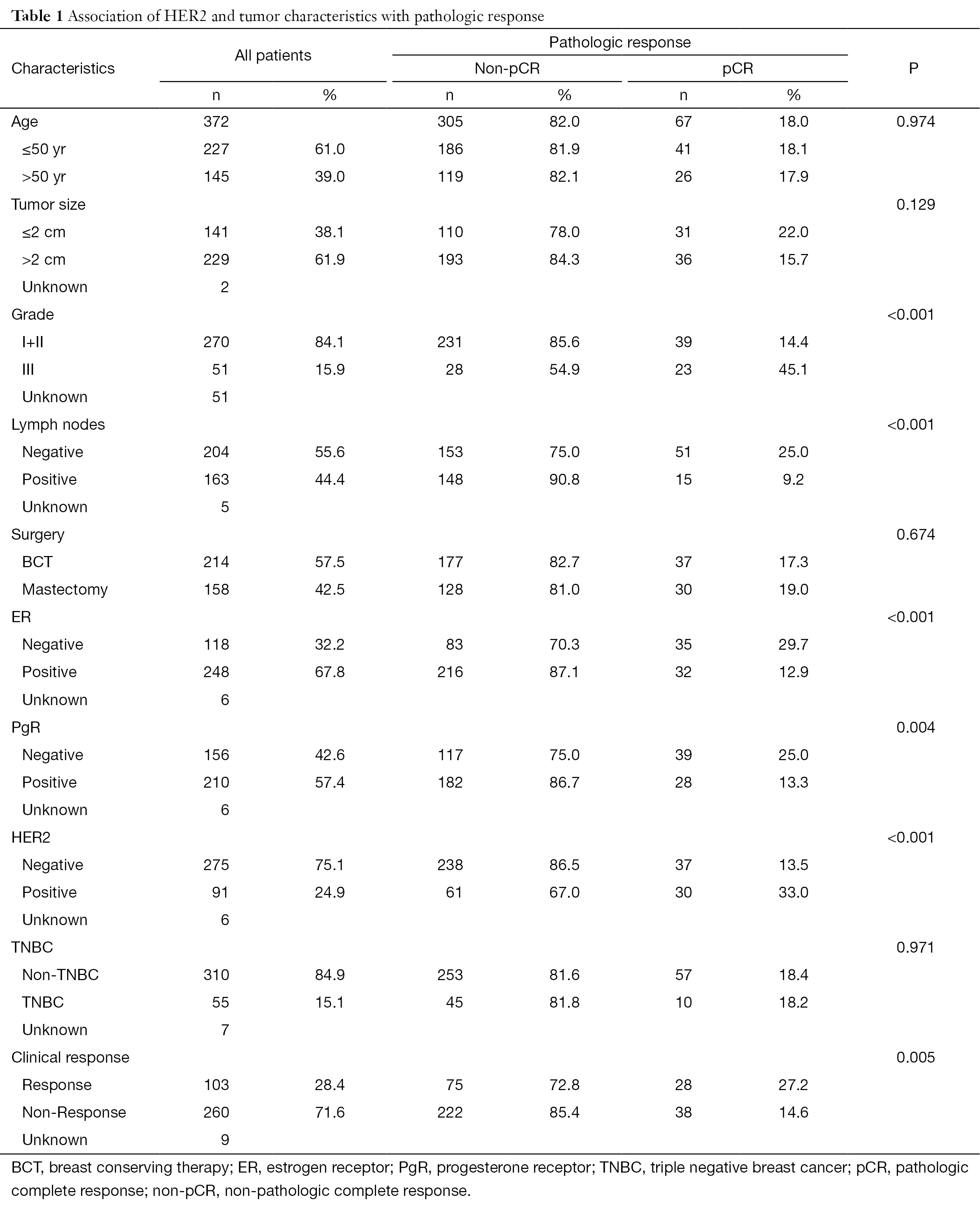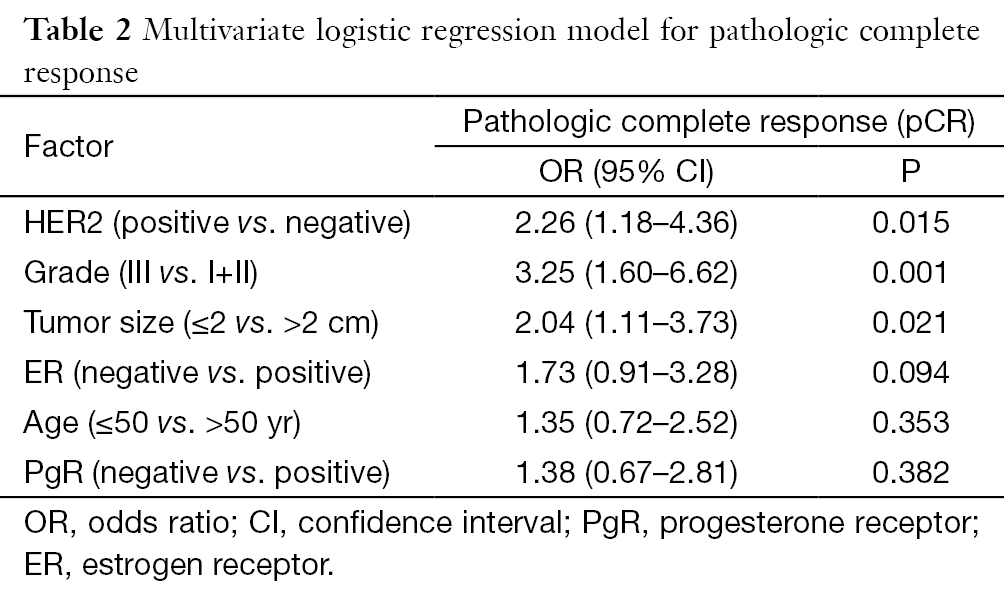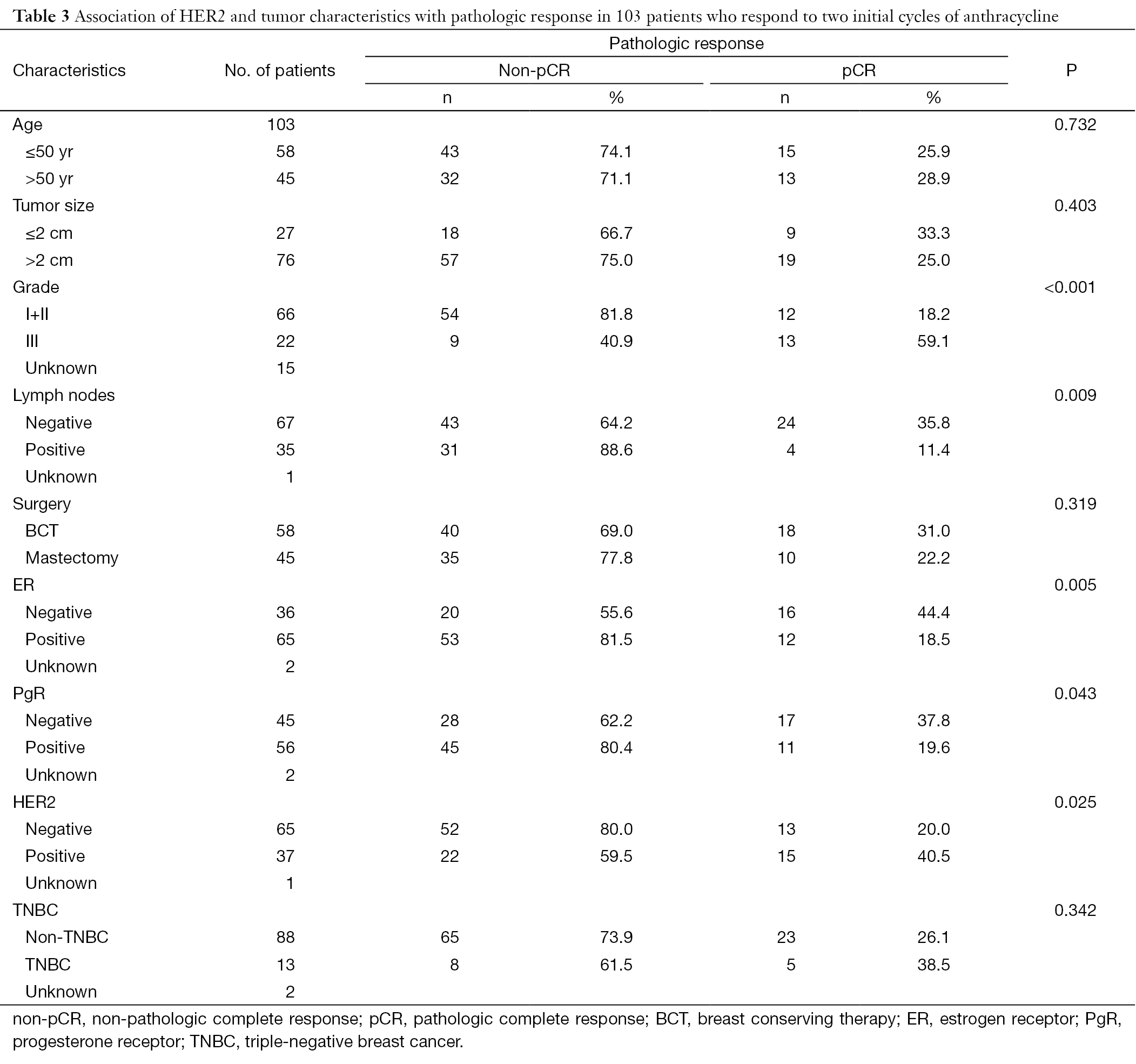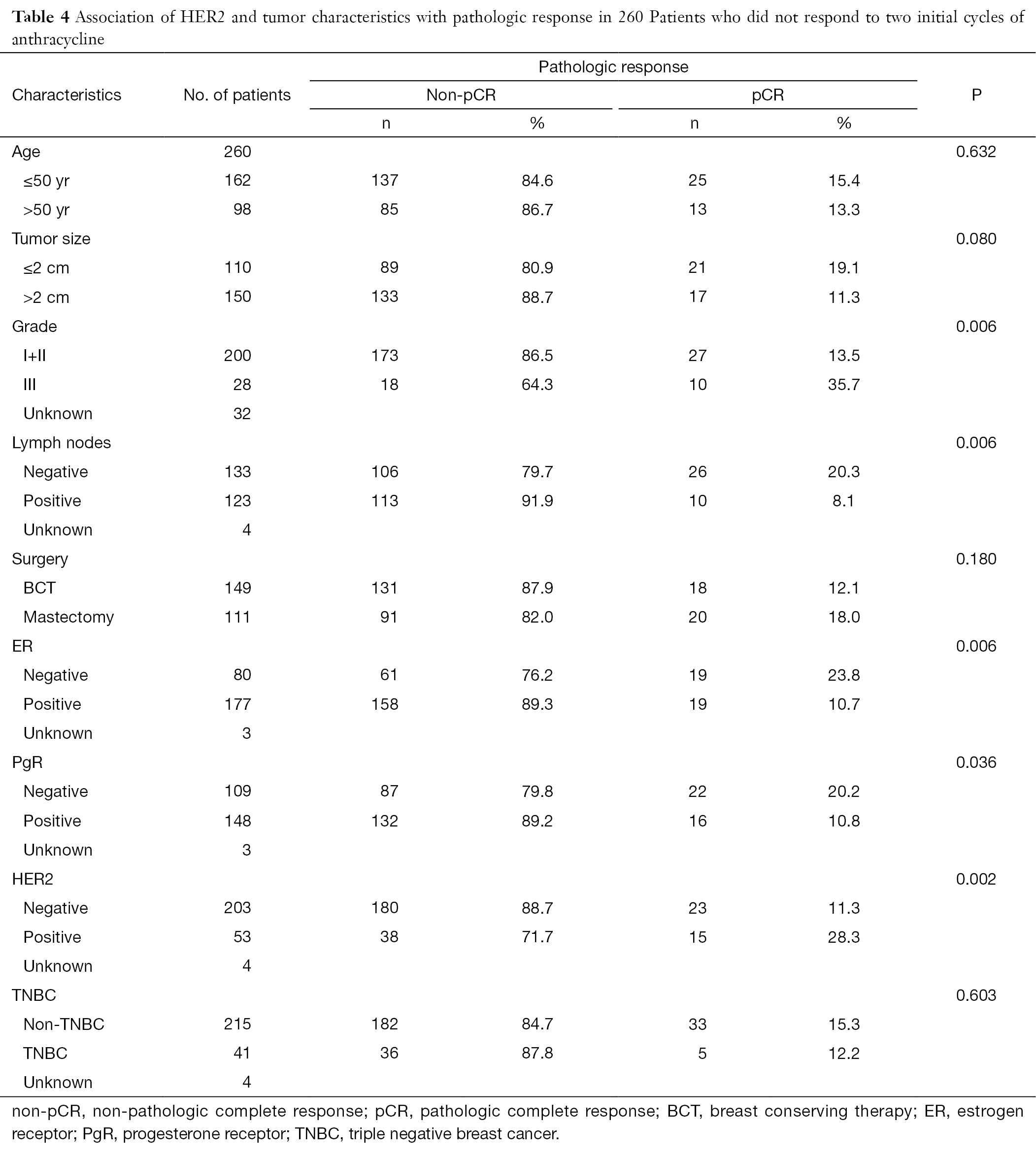Association between HER2 status and response to neoadjuvant anthracycline followed by paclitaxel plus carboplatin chemotherapy without trastuzumab in breast cancer
Introduction
Pathologic complete response (pCR) after neoadjuvant chemotherapy is associated with favorable clinical outcome (1-8) and it serves as a surrogate marker of treatment efficacy.
Anthracyclines and taxanes (paclitaxel or docetaxel) are the most effective cytotoxic agents in breast cancer and form the backbone of most regimens used in the neoadjuvant settings (2,8-10). Several randomized clinical trials demonstrated that the sequential use of paclitaxel after doxorubicin and cyclophosphamide (AC) significantly improved survival as compared with AC alone in both neoadjuvant and adjuvant settings (11-13).
HER2, a member of the epidermal growth factor receptor family, is overexpressed in approximately 20% to 25% of breast cancers and is associated with an unfavorable clinical outcome (14,15). Currently, adjuvant chemotherapy in combination with trastuzumab is a standard therapy for HER2-positive operable primary breast cancers (16,17). We previously showed that HER2-positive breast cancers are less likely to respond to anthracycline-based neoadjuvant chemotherapy in the absence of trastuzumab (18). In contrast, two studies indicated that HER2-positive tumors are likely to benefit from paclitaxel in both adjuvant and metastatic settings under the situation of no trastuzumab treatment (12,19). To date, few studies are available for investigating the association between HER2 status and pathologic response in patients who received neoadjuvant paclitaxel-based regimen (20-23).
Although trastuzumab dramatically improves the survival for HER-2 positive breast cancers (16,24), however, at least one third of Chinese women with HER2-positive breast cancer cannot receive such treatment due to expensive of this targeted therapy. And the disease burden of breast cancer is increasing annually in China (25-27). Therefore, in the current study, we investigated association between the HER2 status and pathologic response in 372 patients who received sequential neoadjuvant anthracycline followed by paclitaxel plus carboplatin regimen without trastuzumab.
Materials and methods
Study population
From April 2003 to November 2008, three hundred seventy-two operable breast cancer patients with stage I to III disease (T1-3, N0-2, M0) were received two cycles anthracyclines followed by 4 cycles paclitaxel plus carboplatin neoadjuvant chemotherapy at the Breast Center, Peking University Cancer Hospital. Patients with HER2-positive tumors in this cohort of 372 patients did not receive neoadjuvant trastuzumab treatment. All patients gave written consent. This study was approved by the Research and Ethics Committee of Peking University Cancer Hospital.
Treatment and response
Three hundred seventy-two patients initially received two cycles of anthracycline-based regimens. Among them, 352 patients received CTF (5-fluorouracil, pirarubicin, and cyclophosphamide) regimen; 16 patients received FEC (5-fluorouracil, epirubicin, and cyclophosphamide) regimen; 4 patients received CAF regimen (5-fluorouracil, doxorubicin, and cyclophosphamide). The detail of the regimens are described previously (18).
After two cycles of anthracyclines, the clinical response of the primary breast cancer was assessed. The clinical size of the primary breast cancer was determined by ultrasound before the start of chemotherapy and after two cycles of anthracyclines, the products of the two greatest perpendicular diameters of primary breast cancer were calculated. Patients in whom the primary breast cancers achieved a partial (reduction of tumor size ≥50%) or complete response after the two cycles were considered as responders; those whose tumors did not achieve a partial response (reduction of tumor size less than 50% or tumor size increase) were considered as non-responders. Both responders and non-responders were received 4 cycles of paclitaxel plus carboplatin regimen. Paclitaxel 175 mg/m2, IV on day 1, carboplatin AUC6, IV on day 1, every 21 day; or paclitaxel 60 mg/m2, IV on day 1, day 8, day 15, carboplatin AUC6, IV on day 1, every 21 day.
After completion of neoadjuvant chemotherapy, patients received either mastectomy or breast conserving therapy (BCT). Pathologic complete response was defined as no invasive breast tumor cells in the breast after completion of neoadjuvant chemotherapy (1,5,7).
Estrogen receptor (ER), progesterone receptor (PgR), and HER2 status
ER, PgR, and HER2 status were determined using the core-needle biopsy breast cancer tissue obtained before initiation of neoadjuvant chemotherapy. ER and PgR were assessed by immunohistochemical assay (18) .
HER2 status was determined by immunohistochemical assay and/or by fluorescence in situ hybridization (FISH) in core-biopsy breast cancer tissue (18).
Statistics analysis
The associations between HER2, clinicopathologic characteristics, and pathologic response to neoadjuvant chemotherapy were determined using Pearson’s χ2 test. A logistic regression model was applied to determine whether a factor was independent predictor of pCR in a multivariate analysis. All statistical tests were two-sided, and P values less than 0.05 were considered as significant. The statistical analyses were performed using SPSS 16.0 software (Chicago, IL, USA).
Results
Associations between HER2 and clinicopathologic characteristics and pCR
The baseline characteristics of the 372 patients are presented in Table 1. Eighteen percent of patients achieved pCR in this cohort of 372 patients (Table 1). Age, tumor size, surgery, and triple-negative breast cancer (ER-, PgR-, and HER2-) were not significantly associated with the pathologic response (Table 1). Patients with lymph-node positive tumors were less likely to achieve a pCR compared with patients with lymph-node negative tumors (9.2% versus 25.0%, P<0.001) (Table 1). ER- or PgR-negative tumors had a higher pCR rate than ER- or PgR-positive tumors (ER, 29.7% versus 12.9%, P<0.001; PgR, 25.0% versus 13.3%, P=0.004), high-grade tumors also had a higher pCR rate than low-grade tumors (III versus I+II: 45.1% versus 14.4%, P<0.001) (Table 1).
HER2 results were available for 366 patients, with 24.9% of patients having a HER2-positive tumor (Table 1). Patients with HER2-positive tumors had a significantly higher pCR rate than did patients with HER2-negative tumors in this cohort (33.0% versus 13.5%, P<0.001) (Table 1). If the pCR was defined as no invasive breast tumor cells in both breast tumors and axillary lymph nodes, there was also a significant association between HER2 status and pCR, HER2-positive tumors showed a higher pCR rate than did HER2-negative tumors in this analysis (27.5% versus 9.8%, P<0.001) (data not shown).
Multivariate analysis revealed that HER2 was an independent favorable predictor of pCR after adjusted for age (≤50 versus >50 yr), tumor size (≤2 versus >2 cm), ER (negative versus positive), PgR (negative versus positive), and tumor grade (III versus I+II) in this cohort of 372 patients [odds ratio (OR), 2.26; 95% confidence interval (CI), 1.18 to 4.36, P=0.015] (Table 2). Patients with HER2-positive tumors were 2.3-fold more likely to respond to neoadjuvant anthracyclines followed by paclitaxel plus carboplatin regimen than patients with HER2-negative tumors. Furthermore, high tumor grade remained as an independent favorable predictor of pCR (Table 2).

Full table

Full table
Association between HER2 and pathologic response in anthracycline response and non-response subgroups
Among the 372 patients, the clinical response was assessed after the two initial cycles of anthracyclines in 363 patients (Table 1). Of these, one hundred and three patients (28.4%) reached a partial or complete response (anthracycline response group), while the remaining 260 patients (71.6%) had stable or progressive disease (anthracycline non-response group) (Table 1). After further treatment with four cycles of paclitaxel plus carboplatin, patients in the anthracycline response group were more likely to respond to paclitaxel plus carboplatin than patients in the anthracycline non-response group (pCR rate: 27.2% versus 14.6%, P=0.005) (Table 1).
HER2-positive tumors had a significant higher pCR rate than did HER2-negative tumors in both anthracycline response group (40.5% versus 20.0%, P=0.025) (Table 3) and anthracycline non-response group (28.3% versus 11.3%, P=0.002) (Table 4). Triple-negative tumors tended to have a higher pCR rate than did non-triple-negative tumor in anthracycline response group (38.5% versus 26.1%, P=0.342) (Table 3); but this was not the case in the anthracycline non-response group (12.2% versus 15.3%, P=0.603) (Table 4).

Full table

Full table
Discussion
We showed that patients with HER2-positive tumors are more likely to benefit from sequential anthracyclines followed by paclitaxel plus carboplatin chemotherapy than those with HER2-negative tumors in a neoadjuvant setting; and HER2 remained as an independent favorable predictor of pCR to this neoadjuvant chemotherapy in a multivariate analysis.
Although most previous studies indicated that patients with HER2-positive tumors are more likely to benefit from adjuvant anthracycline-based chemotherapy (28,29); Bartlett et al. (30) showed that patients with HER2-negative tumor gain a larger benefit from epirubicin than do patients with HER2-positive tumors in an adjuvant setting. We recently also found that HER2-negative tumors have a higher pCR rate than HER2-positive tumors (25.7% versus 14.7%, P=0.013) in 538 operable primary breast cancer patients who received neoadjuvant anthracycline-based chemotherapy (18). Therefore, our previous study together with Bartlett study suggested that HER2-positive tumors are less likely to benefit from anthracycline chemotherapy in both adjuvant and neoadjuvant settings.
In the present study, the observation that HER2-positive tumors had a higher pCR rate than HER2-negative tumors is therefore likely due to the effect from paclitaxel or combined with carboplatin. Our finding was concordant with previous observation that paclitaxel is more efficacious in HER2-positive tumors than in HER2-negative tumors in both adjuvant and metastatic settings (12,19). Hayes et al. (12) showed that patients with HER2-positive tumors benefit from the addition of paclitaxel after receiving four cycles of doxorubicin plus cyclophosphamide in an adjuvant setting.
In this study, patients who responded to two initial cycles of anthracycline were more likely to respond paclitaxel plus carboplatin than those who did not. This finding is agreement with a previous study that patients who respond to initial chemotherapy regimen are more likely to respond to additional non-cross-resistant therapy (8). On the other hand, patients who do not respond to initial neoadjuvant chemotherapy are unlikely to respond to a non-cross-resistant regimen in both Aberdeen trial (8) and GeparTrio trial (31). In the Aberdeen trial (8), patients who do not respond to four initial cycles of anthracycline are unlikely to respond to docetaxel, the pCR rate is only 2% in non-response group in this trial. In our present study, the pCR rate was 14.6% in the anthracycline non-response group and it is higher than that of Aberdeen trial. The discrepancy between our study and Aberdeen study may be due to two reasons. First, our regimen contains paclitaxel plus carboplatin compared with single agent docetaxel in Aberdeen study; second, 38.1% of patients with small tumor size (i.e., ≤2 cm) were in our cohort compared with only large and advanced breast cancers in Aberdeen study. Small tumors are more likely to achieve pCR in many studies. Due to no anthracycline alone arm in our study, we cannot rule out that patients who do not respond to anthracycline may gain additional benefit from paclitaxel plus carboplatin regimen. Nevertheless, after completion of four cycles of paclitaxel plus carboplatin, patients with HER2-positive tumors had a significantly higher pCR rate than HER2-negative tumors in both anthracycline response group and anthracycline non-response group. These findings suggested that HER2-positive tumors derive a larger benefit from paclitaxel-carboplatin-based regimen in anthracycline response and non-response groups.
In the present study, triple-negative tumors did not have a higher pCR rate than non-triple-negative tumors in the entire cohort of 372 patients. It has been postulated that triple-negative tumors are sensitive to DNA-damaging chemotherapeutic agents like the platinum analogs (32). A recent study showed that only 22% of patients achieved pCR in 28 triple-negative patients who received neoadjuvant single cisplatin agent (33). Although carboplatin is a component in our present regimen, we failed to find triple-negative tumors significantly responded to paclitaxel plus carboplatin regimen. However, in the anthracycline response group, triple-negative breast cancers tended to have a higher pCR rate than non-triple negative breast cancers, but such tendency was not found in the anthracycline non-response group. We previously found triple-negative breast cancers are more likely to respond to neoadjuvant anthracycline (18).
In conclusion, our study indicated that patients with HER2-positive tumors are more likely to respond to paclitaxel-carboplatin-based regimen in a neoadjuvant setting no matter whether the tumors respond to initial anthracycline or not. Since some HER2-positive breast cancer patients do not have a chance to receive trastuzumab treatment due to economic issues in China, these patients can gain a large benefit from anthracycline followed by paclitaxel plus carboplatin neoadjuvant chemotherapy without trastuzumab treatment.
Acknowledgements
Funding: This study was supported by grants from the National Natural Science Foundation of China (No.81302330, No. 30973436 and No. 81071629); the National Key Technology Research and Development Program of the Ministry of Science and Technology of China (No. 2014BAI09B08); the 973 project 2013CB911004 and the 985-III project.
Footnote
Conflicts of Interest: The authors have no conflicts of interest to declare.
References
- Fisher B, Bryant J, Wolmark N, et al. Effect of preoperative chemotherapy on the outcome of women with operable breast cancer. J Clin Oncol 1998;16:2672-85. [PubMed]
- Rastogi P, Anderson SJ, Bear HD, et al. Preoperative chemotherapy: updates of National Surgical Adjuvant Breast and Bowel Project Protocols B-18 and B-27. J Clin Oncol 2008;26:778-85. [PubMed]
- Kuerer HM, Newman LA, Smith TL, et al. Clinical course of breast cancer patients with complete pathologic primary tumor and axillary lymph node response to doxorubicin-based neoadjuvant chemotherapy. J Clin Oncol 1999;17:460-9. [PubMed]
- Guarneri V, Broglio K, Kau SW, et al. Prognostic value of pathologic complete response after primary chemotherapy in relation to hormone receptor status and other factors. J Clin Oncol 2006;24:1037-44. [PubMed]
- Liedtke C, Mazouni C, Hess KR, et al. Response to neoadjuvant therapy and long-term survival in patients with triple-negative breast cancer. J Clin Oncol 2008;26:1275-81. [PubMed]
- Gralow JR, Burstein HJ, Wood W, et al. Preoperative therapy in invasive breast cancer: pathologic assessment and systemic therapy issues in operable disease. J Clin Oncol 2008;26:814-9. [PubMed]
- Bear HD, Anderson S, Brown A, et al. The effect on tumor response of adding sequential preoperative docetaxel to preoperative doxorubicin and cyclophosphamide: preliminary results from National Surgical Adjuvant Breast and Bowel Project Protocol B-27. J Clin Oncol 2003;21:4165-74. [PubMed]
- Smith IC, Heys SD, Hutcheon AW, et al. Neoadjuvant chemotherapy in breast cancer: significantly enhanced response with docetaxel. J Clin Oncol 2002;20:1456-66. [PubMed]
- Gianni L, Baselga J, Eiermann W, et al. Phase III trial evaluating the addition of paclitaxel to doxorubicin followed by cyclophosphamide, methotrexate, and fluorouracil, as adjuvant or primary systemic therapy: European Cooperative Trial in Operable Breast Cancer. J Clin Oncol 2009;27:2474-81. [PubMed]
- Untch M, Möbus V, Kuhn W, et al. Intensive dose-dense compared with conventionally scheduled preoperative chemotherapy for high-risk primary breast cancer. J Clin Oncol 2009;27:2938-45. [PubMed]
- Mamounas EP, Bryant J, Lembersky B, et al. Paclitaxel after doxorubicin plus cyclophosphamide as adjuvant chemotherapy for node-positive breast cancer: results from NSABP B-28. J Clin Oncol 2005;23:3686-96. [PubMed]
- Hayes DF, Thor AD, Dressler LG, et al. HER2 and response to paclitaxel in node-positive breast cancer. N Engl J Med 2007;357:1496-506. [PubMed]
- Martín M, Rodriguez-Lescure A, Ruiz A, et al. Randomized phase 3 trial of fluorouracil, epirubicin, and cyclophosphamide alone or followed by Paclitaxel for early breast cancer. J Natl Cancer Inst 2008;100:805-14. [PubMed]
- Romond EH, Perez EA, Bryant J, et al. Trastuzumab plus adjuvant chemotherapy for operable HER2-positive breast cancer. N Engl J Med 2005;353:1673-84. [PubMed]
- Révillion F, Bonneterre J, Peyrat JP. ERBB2 oncogene in human breast cancer and its clinical significance. Eur J Cancer 1998;34:791-808. [PubMed]
- Coates AS, Winer EP, Goldhirsch A, et al. -Tailoring therapies-improving the management of early breast cancer: St Gallen International Expert Consensus on the Primary Therapy of Early Breast Cancer 2015. Ann Oncol 2015;26:1533-46. [PubMed]
- Rimawi MF, Schiff R, Osborne CK. Targeting HER2 for the treatment of breast cancer. Annu Rev Med 2015;66:111-28. [PubMed]
- Yao L, Liu Y, Li Z, et al. HER2 and response to anthracycline-based neoadjuvant chemotherapy in breast cancer. Ann Oncol 2011;22:1326-31. [PubMed]
- Konecny GE, Thomssen C, Lück HJ, et al. Her-2/neu gene amplification and response to paclitaxel in patients with metastatic breast cancer. J Natl Cancer Inst 2004;96:1141-51. [PubMed]
- Huober J, von Minckwitz G, Denkert C, et al. Effect of neoadjuvant anthracycline-taxane-based chemotherapy in different biological breast cancer phenotypes: overall results from the GeparTrio study. Breast Cancer Res Treat 2010;124:133-40. [PubMed]
- Montagna E, Bagnardi V, Rotmensz N, et al. Pathological complete response after preoperative systemic therapy and outcome: relevance of clinical and biologic baseline features. Breast Cancer Res Treat 2010;124:689-99. [PubMed]
- Darb-Esfahani S, Loibl S, Müller BM, et al. Identification of biology-based breast cancer types with distinct predictive and prognostic features: role of steroid hormone and HER2 receptor expression in patients treated with neoadjuvant anthracycline/taxane-based chemotherapy. Breast Cancer Res 2009;11:R69. [PubMed]
- Rouzier R, Perou CM, Symmans WF, et al. Breast cancer molecular subtypes respond differently to preoperative chemotherapy. Clin Cancer Res 2005;11:5678-85. [PubMed]
- Yan M, Lv HM, Zhang MW, et al. Maintenance treatment of trastuzumab for patients with advanced breast cancer to achieve long term survival: two case reports and literature review. Chin J Cancer Res 2014;26:486-92. [PubMed]
- Chen W, Zheng R, Zhang S, et al. Report of incidence and mortality in China cancer registries, 2009. Chin J Cancer Res 2013;25:10-21. [PubMed]
- Chen W, Zheng R, Zhang S, et al. Annual report on status of cancer in China, 2010. Chin J Cancer Res 2014;26:48-58. [PubMed]
- Chen W, Zheng R, Zeng H, et al. Annual report on status of cancer in China, 2011. Chin J Cancer Res 2015;27:2-12. [PubMed]
- Pritchard KI, Shepherd LE, O'Malley FP, et al. HER2 and responsiveness of breast cancer to adjuvant chemotherapy. N Engl J Med 2006;354:2103-11. [PubMed]
- Gennari A, Sormani MP, Pronzato P, et al. HER2 status and efficacy of adjuvant anthracyclines in early breast cancer: a pooled analysis of randomized trials. J Natl Cancer Inst 2008;100:14-20. [PubMed]
- Bartlett JM, Munro A, Cameron DA, et al. Type 1 receptor tyrosine kinase profiles identify patients with enhanced benefit from anthracyclines in the BR9601 adjuvant breast cancer chemotherapy trial. J Clin Oncol 2008;26:5027-35. [PubMed]
- von Minckwitz G, Kümmel S, Vogel P, et al. Intensified neoadjuvant chemotherapy in early-responding breast cancer: phase III randomized GeparTrio study. J Natl Cancer Inst 2008;100:552-62. [PubMed]
- Staudacher L, Cottu PH, Diéras V, et al. Platinum-based chemotherapy in metastatic triple-negative breast cancer: the Institut Curie experience. Ann Oncol 2011;22:848-56. [PubMed]
- Silver DP, Richardson AL, Eklund AC, et al. Efficacy of neoadjuvant Cisplatin in triple-negative breast cancer. J Clin Oncol 2010;28:1145-53. [PubMed]
